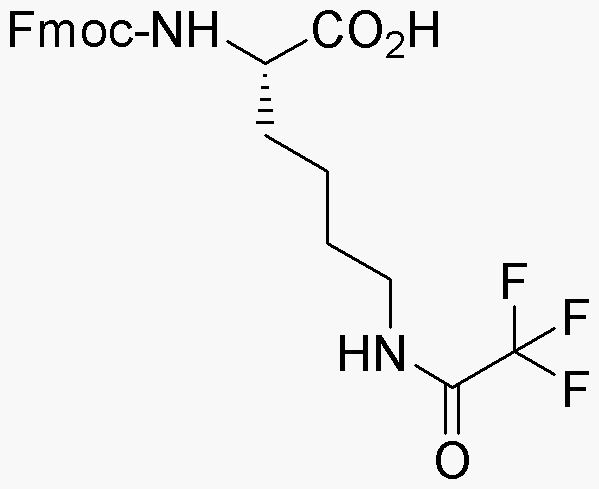Na-Fmoc-Ne-trifluoroacetyl-L-lysine is widely utilized in research focused on:
- Peptide Synthesis: This compound serves as a key building block in the synthesis of peptides, particularly in solid-phase peptide synthesis, enabling researchers to create complex peptide sequences efficiently.
- Drug Development: Its unique protective groups allow for selective reactions, making it valuable in the pharmaceutical industry for developing new therapeutic peptides with enhanced stability and bioactivity.
- Bioconjugation: The trifluoroacetyl group can be used to facilitate bioconjugation processes, allowing for the attachment of various biomolecules, which is essential in creating targeted drug delivery systems.
- Protein Engineering: Researchers utilize this compound in the modification of lysine residues in proteins, which can help in studying protein interactions and functions, ultimately aiding in the design of novel proteins.
- Analytical Chemistry: It is also employed in analytical methods for characterizing peptides and proteins, providing insights into their structure and function, which is crucial for quality control in biopharmaceuticals.
General Information
Properties
Safety and Regulations
Applications
Na-Fmoc-Ne-trifluoroacetyl-L-lysine is widely utilized in research focused on:
- Peptide Synthesis: This compound serves as a key building block in the synthesis of peptides, particularly in solid-phase peptide synthesis, enabling researchers to create complex peptide sequences efficiently.
- Drug Development: Its unique protective groups allow for selective reactions, making it valuable in the pharmaceutical industry for developing new therapeutic peptides with enhanced stability and bioactivity.
- Bioconjugation: The trifluoroacetyl group can be used to facilitate bioconjugation processes, allowing for the attachment of various biomolecules, which is essential in creating targeted drug delivery systems.
- Protein Engineering: Researchers utilize this compound in the modification of lysine residues in proteins, which can help in studying protein interactions and functions, ultimately aiding in the design of novel proteins.
- Analytical Chemistry: It is also employed in analytical methods for characterizing peptides and proteins, providing insights into their structure and function, which is crucial for quality control in biopharmaceuticals.
Documents
Safety Data Sheets (SDS)
The SDS provides comprehensive safety information on handling, storage, and disposal of the product.
Product Specification (PS)
The PS provides a comprehensive breakdown of the product’s properties, including chemical composition, physical state, purity, and storage requirements. It also details acceptable quality ranges and the product's intended applications.
Certificates of Analysis (COA)
Search for Certificates of Analysis (COA) by entering the products Lot Number. Lot and Batch Numbers can be found on a product’s label following the words ‘Lot’ or ‘Batch’.
*Catalog Number
*Lot Number
Certificates Of Origin (COO)
This COO confirms the country where the product was manufactured, and also details the materials and components used in it and whether it is derived from natural, synthetic, or other specific sources. This certificate may be required for customs, trade, and regulatory compliance.
*Catalog Number
*Lot Number
Safety Data Sheets (SDS)
The SDS provides comprehensive safety information on handling, storage, and disposal of the product.
DownloadProduct Specification (PS)
The PS provides a comprehensive breakdown of the product’s properties, including chemical composition, physical state, purity, and storage requirements. It also details acceptable quality ranges and the product's intended applications.
DownloadCertificates of Analysis (COA)
Search for Certificates of Analysis (COA) by entering the products Lot Number. Lot and Batch Numbers can be found on a product’s label following the words ‘Lot’ or ‘Batch’.
*Catalog Number
*Lot Number
Certificates Of Origin (COO)
This COO confirms the country where the product was manufactured, and also details the materials and components used in it and whether it is derived from natural, synthetic, or other specific sources. This certificate may be required for customs, trade, and regulatory compliance.


